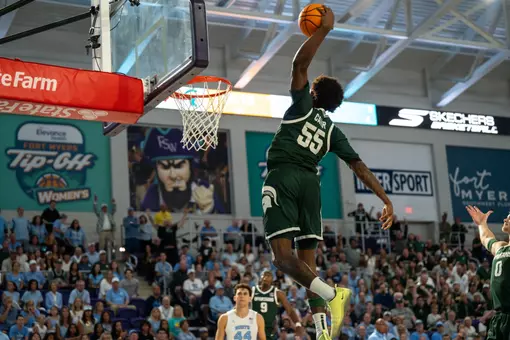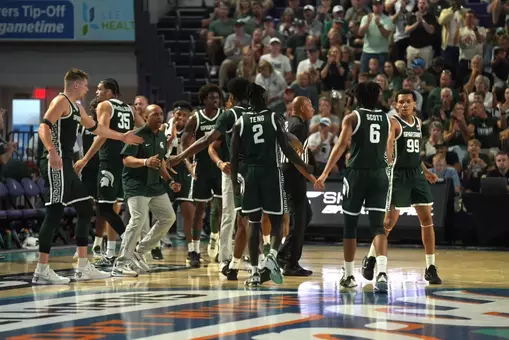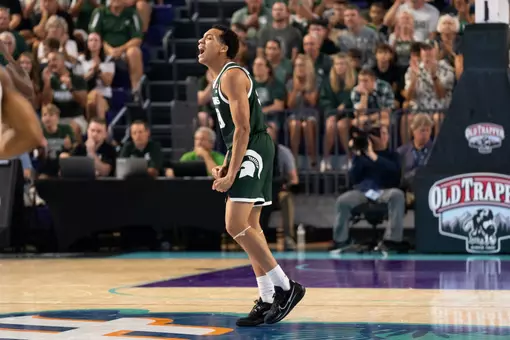MSU Athletics Hall of Fame Class of 2010: Julius McCoy
10/1/2010 12:00:00 AM | Men's Basketball
Oct. 1, 2010

JULIUS McCOY
Men's Basketball (1953-56)
Farrell, Pa.
One of the most prolific scorers in the storied history of the Michigan State basketball program, forward Julius McCoy finished his career in 1956 as the all-time leading scorer in the school record books with 1,377 points. More than 50 years later, McCoy still ranks among the top 25 at MSU in scoring, and his 20.9-point career scoring average is third all-time.
McCoy's breakthrough season came in 1955-56, as he averaged 27.2 points, nearly tripling the second-best scoring average on the team. His 27.2 scoring average still ranks fourth best in an MSU single-season. McCoy scored at least 35 points in four games that season, including a career-high 45 in a win over Notre Dame on Dec. 21, 1955, which is tied for third-most ever by a Spartan player in a single game.
For his efforts, McCoy became the first Spartan men's basketball player to be named to the All-Big Ten First Team and garnered team MVP honors. He also landed on several All-America teams, including the Associated Press, United Press International, and the National Association of Basketball Coaches.
"Julius was pretty humble for what he accomplished," said former MSU men's basketball head coach Gus Ganakas, who got to know McCoy after taking over the Spartan program and had watched McCoy while coaching East Lansing High School in the 1950s. "Everybody respected him highly. No question he belongs in the Hall of Fame. In the era he played, for the people that remember him, they all hold him in high regard. He was considered one of the best players during that time."
After appearing in the 1956 College All-Star Game, McCoy was drafted by the NBA's St. Louis Hawks, but he was also drafted in a different realm that same year - by the U.S. Army. Following his service, he played for 13 seasons in the Eastern Basketball Association (later know as the CBA). He earned Rookie of the Year honors, was a six-time All Star, and was a member of the CBA's 50th-anniversary All-Star Team.
McCoy passed away at the age of 76 in April 2008.
"On behalf of the Julius McCoy family, I would like to thank you so much for acknowledging him," said Judy McCoy Jordan at the Hall of Fame induction ceremony Oct. 1, who accepted the Hall of Fame plaque on behalf of her deceased father. "Unfortunately we lost him two years ago, but believe me he is a Spartan up in heaven. If there is a basketball court he's actually up there playing."
..............................................................................
The following story was written by Jack Ebling for msuspartans.com on April 8, 2008.
THE REAL McCOY
By Jack Ebling, MSUSpartans.com on-line columnist
They called him "Hooks" because of his hands, not for one of the shots in his repertoire.
But Michigan State star Julius McCoy could have had another nickname.
"The One Who Got Away."
The three-sport standout from Farrell, Pa., not far from Pittsburgh, got away from Penn State after a recruiting blunder.
He got away from so many opponents from 1953-56 that he broke nearly all the Spartans' game, season and career scoring marks.
 When Julius McCoy left Michigan State in 1956, he did so as the program's all-time leading scorer with 1,377 career points. |
|
He also got away from the NBA and became the all-time leading scorer in the Eastern Basketball Association.
"I just tried to make a move and get the ball to the basket," McCoy said nearly a decade before his death last Friday at age 76. "I never shot a lot of hooks. I was a forward, not a center. Most of my shots came from 17 feet or on drives to the basket."
He could have made those left-handed shots for the Nittany Lions, a Final Four team in 1954, if then-MSC assistant football coach Duffy Daugherty hadn't been around.
McCoy, an All-Pennsylvania halfback, was so good the Pittsburgh Steelers tried to sign him after his senior year of high school.
But the Western PA 100- and 220-yard dash champion loved basketball, too, and was one of the top offensive players in the nation in 1952.
"I never knew which sport I wanted to play," McCoy said. "But Penn State said, `We don't give a darn about basketball. We just want you for football.'"
Daugherty, who loved to recruit in his home state, took a different approach and proved he cared about McCoy as a person, not just a prospect.
"Duffy said, `Whichever sport you choose, the important thing to me is that you come to Michigan State,'" McCoy said. "At that very moment, I decided to do that."
When McCoy chose to concentrate on basketball as a freshman and sophomore, no one could have been happier than Hall of Fame hoops coach Pete Newell.
"Julius was an All-World basketball player in high school," Newell said. "He was the best kid I ever recruited, in terms of national reputation."
McCoy averaged 18.6 points per game as a sophomore in his varsity debut and connected in every conceivable way, including a last-second free throw that beat Illinois.
"Julius possesses more natural ability as a scorer than anyone we've ever had," assistant coach John Benington said in 1953. "He has about as wide a variety of shots as you could ask for."
McCoy took his glasses off and tried contact lenses - and football - as a junior. But an ankle injury cut his scoring average to 16.7 in his first season under Forddy Anderson.
McCoy returned with glasses as a senior and drew rave reviews, smashing Al Ferrari's school single-game scoring mark of 35 points and doing it by double-digits.
"Seven Notre Dame firefighters tried in vain to put out the blaze but were forced back by the flames as McCoy poured 45 points through the hoop," State Journal writer Lad Slingerland said of a record that stood for more than two decades.
In a memorable duel with Ohio State gunner Robin Freeman, McCoy was outscored 46-40 but had a steal and a score for the winning points - all that mattered to him.
"To win that game was the highlight of my career," McCoy said. "Robin was one of the greatest shooters ever to play the game. To match him that way and leave with a win was something I'll always be proud of."
McCoy was 15-for-26 from the field and 10-for-12 at the line in that 94-91 comeback triumph, the greatest duel in Jenison Field House history.
|
McCoy was the first Spartan to be named to the All-Big Ten First Team. He averaged 27.2 points his senior season in 1956-57.
|
He also had 41 points in a victory over Michigan, one of his five wins in six games against the Wolverines.
"Michigan was always a grudge game," McCoy said. "We knew it would be a blood-and-guts, win-at-all-cost game. And we beat them five in a row."
Against players like the Wolverines' football-basketball star Ron Kramer, respect came slowly but was McCoy's to keep.
"He's the real thing, and his name is Julius," George E. Van of the Detroit Times said. "It's obvious he never had a rattle, or anything else, as a toy. He must have started with a basketball."
Whatever skills he had at the start, he kept under Anderson's tutelage. For a coach who loved scorers, McCoy was quite the inheritance.
"I often said at clinics, `Julius did everything wrong. He shot on the way down. He shot off-balance. And he had lousy fundamentals. . . . All he did was break every scoring record," Anderson said.
McCoy broke Al Ferrari's Spartan career mark by 268 points and finished with 1,377 in three seasons and 66 games - still No. 19 on the MSU's all-time list.
"Julius got all my shots when I left," Ferrari said. "He averaged almost 28 points a game. He was a fabulous player."
He was a second- or third-team All-American on most respected lists in 1956, despite giving up several inches in height to most opponents at just 6-foot-2.
"Height is no handicap," McCoy said. "If a person can play basketball, that's all that matters. The rest of it is a lot of bunk, as far as I'm concerned."
The Big Ten's No. 2 scorer behind Freeman played for Newell, then at California, in the 1956 East-West All-Star Game in New York's Madison Square Garden.
He also had 17 points for the College All-Stars against the Harlem Globetrotters in Detroit's Olympia Stadium, as his team went a respectable 10-11 on that nationwide tour.
McCoy was sought by the St. Louis Hawks but was drafted into the U.S. Army. When he re-entered civilian life in 1958, the Hawks had just beaten Boston for the NBA title and decided not to make any changes.
Instead, McCoy signed with the EBA, later known as the CBA, and played 13 seasons, once making 27 free throws in a game.
He was the league's Rookie of the Year, a six-time All-Star and a member of the CBA's 50th-Anniversary All-Star Team.
"One of the saddest things to me was that Julius never made it to the NBA," said Ferrari, who spent six years in the league. "He was so fast. And when he came to camp with the Hawks, I was really worried he might take my job.
"But when he didn't make it with us, the Pistons wouldn't even give him a look. With only eight teams and 88 players, it was tough to make it in the NBA."
Instead, McCoy spent more than 30 years with the Pennsylvania Department of Transportation and more than 50 seasons following his beloved Spartans - two grateful teams that never let him get away.




